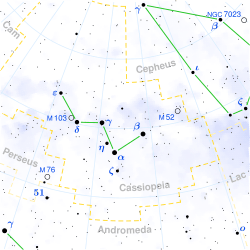Mu Cassiopeiae
 | |
| Observation data Epoch J2000 Equinox J2000 | |
|---|---|
| Constellation | Cassiopeia |
| Right ascension | 01h 08m 16.39470s[1] |
| Declination | +54° 55′ 13.2264″[1] |
| Apparent magnitude (V) | 5.159[2]/11 |
| Characteristics | |
| Spectral type | G5Vb[3] |
| U−B color index | +0.10[4] |
| B−V color index | +0.70[4] |
| Variable type | Suspected[5] |
| Astrometry | |
| Radial velocity (Rv) | −98.3[2] km/s |
| Proper motion (μ) | RA: 3,422.23[1] mas/yr Dec.: −1,598.93[1] mas/yr |
| Parallax (π) | 132.38 ± 0.82[1] mas |
| Distance | 24.6 ± 0.2 ly (7.55 ± 0.05 pc) |
| Absolute magnitude (MV) | 5.77[2]/11.6 |
| Orbit[6] | |
| Companion | μ Cas B |
| Period (P) | 21.75 yr |
| Semi-major axis (a) | 1.01″ |
| Eccentricity (e) | 0.56 |
| Inclination (i) | 110° |
| Longitude of the node (Ω) | 47.3° |
| Periastron epoch (T) | 1975.74 |
| Argument of periastron (ω) (secondary) | 152.7° |
| Details | |
| A | |
| Mass | 0.74[6] M☉ |
| Radius | 0.791 ± 0.008[7] R☉ |
| Luminosity | 0.442 ± 0.014[7] L☉ |
| Surface gravity (log g) | 4.51[8] cgs |
| Temperature | 5,332[8] K |
| Metallicity [Fe/H] | −0.84[8] dex |
| Rotational velocity (v sin i) | 8[9] km/s |
| Age | 3.1[2]–5.9[10] Gyr |
| B | |
| Mass | 0.17[6] M☉ |
| Radius | 0.29[11] R☉ |
| Luminosity | 0.0062[11] L☉ |
| Other designations | |
| Database references | |
| SIMBAD | data |
Mu Cassiopeiae (μ Cas, μ Cassiopeiae) is a binary star system in the constellation Cassiopeia. This system shares the name Marfak with Theta Cassiopeiae, and the name was from Al Marfik or Al Mirfaq (المرفق), meaning "the elbow".[12]
In 1961 the close binary nature of this system was discovered by Nicholas E. Wagman at the Allegheny Observatory.[13] Since then the orbital elements of the two stars have been fairly well established. The two stars are separated by a semimajor axis of 7.61 AUs with distance range of 3.3-11.9 AUs. In 1966, the individual components were first resolved by the American astronomer Peter A. Wehinger using the 84-inch reflector at the Kitt Peak National Observatory, allowing an initial estimate of separate masses.[14]
Compared to other nearby stars, this pair are moving at a relatively high velocity of 167 km/s through the Milky Way galaxy. They are low metal, Population II stars that are thought to have formed before the galactic disk first appeared.
This star will be in constellation Perseus around 5200 AD.[15]
References
- 1 2 3 4 5 van Leeuwen, F. (November 2007), "Validation of the new Hipparcos reduction", Astronomy and Astrophysics, 474 (2): 653–664, arXiv:0708.1752, Bibcode:2007A&A...474..653V, doi:10.1051/0004-6361:20078357
- 1 2 3 4 Nordström, B.; et al. (May 2004), "The Geneva-Copenhagen survey of the Solar neighbourhood. Ages, metallicities, and kinematic properties of ˜14 000 F and G dwarfs", Astronomy and Astrophysics, 418 (3): 989–1019, arXiv:astro-ph/0405198, Bibcode:2004A&A...418..989N, doi:10.1051/0004-6361:20035959
- ↑ Keenan, Philip C; McNeil, Raymond C (1989). "The Perkins catalog of revised MK types for the cooler stars". Astrophysical Journal Supplement Series. 71: 245. Bibcode:1989ApJS...71..245K. doi:10.1086/191373.
- 1 2 Carney, B. W. (October 1979), "Subdwarf ultraviolet excesses and metal abundances", Astrophysical Journal, Part 1, 233: 211–225, Bibcode:1979ApJ...233..211C, doi:10.1086/157383
- ↑ Samus, N. N.; Durlevich, O. V.; et al. (2009). "VizieR Online Data Catalog: General Catalogue of Variable Stars (Samus+ 2007-2013)". VizieR On-line Data Catalog: B/gcvs. Originally published in: 2009yCat....102025S. 1. Bibcode:2009yCat....102025S.
- 1 2 3 Gontcharov, G. A.; Kiyaeva, O. V. (August 2002), "Photocentric orbits from a direct combination of ground-based astrometry with Hipparcos. I. Comparison with known orbits", Astronomy and Astrophysics, 391 (2): 647–657, Bibcode:2002A&A...391..647G, doi:10.1051/0004-6361:20020896
- 1 2 Boyajian, Tabetha S.; et al. (August 2008), "Angular Diameters of the G Subdwarf μ Cassiopeiae A and the K Dwarfs σ Draconis and HR 511 from Interferometric Measurements with the CHARA Array", The Astrophysical Journal, 683 (1): 424–432, arXiv:0804.2719, Bibcode:2008ApJ...683..424B, doi:10.1086/589554
- 1 2 3 Soubiran, C.; et al. (March 2008), "Vertical distribution of Galactic disk stars. IV. AMR and AVR from clump giants", Astronomy and Astrophysics, 480 (1): 91–101, arXiv:0712.1370, Bibcode:2008A&A...480...91S, doi:10.1051/0004-6361:20078788
- ↑ Takeda, Yoichi; et al. (February 2005), "High-Dispersion Spectra Collection of Nearby F--K Stars at Okayama Astrophysical Observatory: A Basis for Spectroscopic Abundance Standards", Publications of the Astronomical Society of Japan, 57 (1): 13–25, Bibcode:2005PASJ...57...13T, doi:10.1093/pasj/57.1.13
- ↑ Mamajek, Eric E.; et al. (November 2008), "Improved Age Estimation for Solar-Type Dwarfs Using Activity-Rotation Diagnostics", The Astrophysical Journal, 687 (2): 1264–1293, arXiv:0807.1686, Bibcode:2008ApJ...687.1264M, doi:10.1086/591785
- 1 2 Drummond, Jack D; Christou, Julian C; Fugate, Robert Q (1995). "Full Adaptive Optics Images of ADS 9731 and MU Cassiopeiae: Orbits and Masses". Astrophysical Journal. 450: 380. Bibcode:1995ApJ...450..380D. doi:10.1086/176148.
- ↑ Allen, R. H. (1963), Star Names: Their Lore and Meaning (Reprint ed.), New York: Dover Publications Inc, p. 148, ISBN 0-486-21079-0, retrieved 2010-12-12
- ↑ Lippincott, S. L.; Wyckoff, S. (September 1964), "Parallax and orbital motion of the astrometric binary mu Cassiopeiae from photographs taken with the 24-inch Sproul refractor", Astronomical Journal, 69: 471&ndash, 474, Bibcode:1964AJ.....69..471L, doi:10.1086/109301
- ↑ Wehinger, Peter A.; Wyckoff, Susan (February 1966), "Preliminary Mass Determination of μ Cas", Astronomical Journal, 71: 185, Bibcode:1966AJ.....71Q.185W, doi:10.1086/110028
- ↑ p. 296, Patrick Moore's Data Book of Astronomy, Patrick Moore and Robin Rees, Cambridge, Cambridge University Press, 2011.
External links
- Heintz, W. D.; Cantor, B. A. (1994). "An astrometric study of four binary stars". Publications of the Astronomical Society of the Pacific. 106: 363–364. Bibcode:1994PASP..106..363H. doi:10.1086/133386.
- SolStation entry
- Mu Cassiopeiae by Professor Jim Kaler.